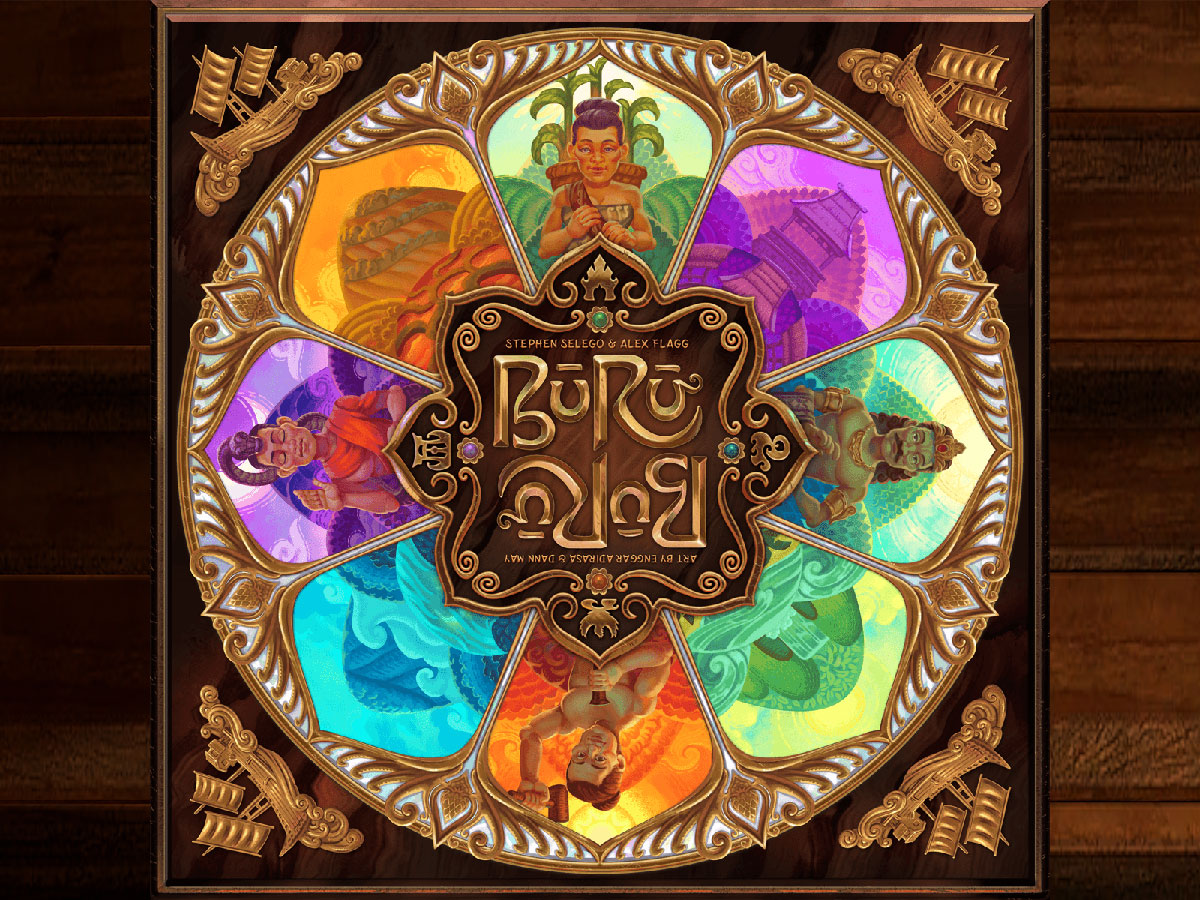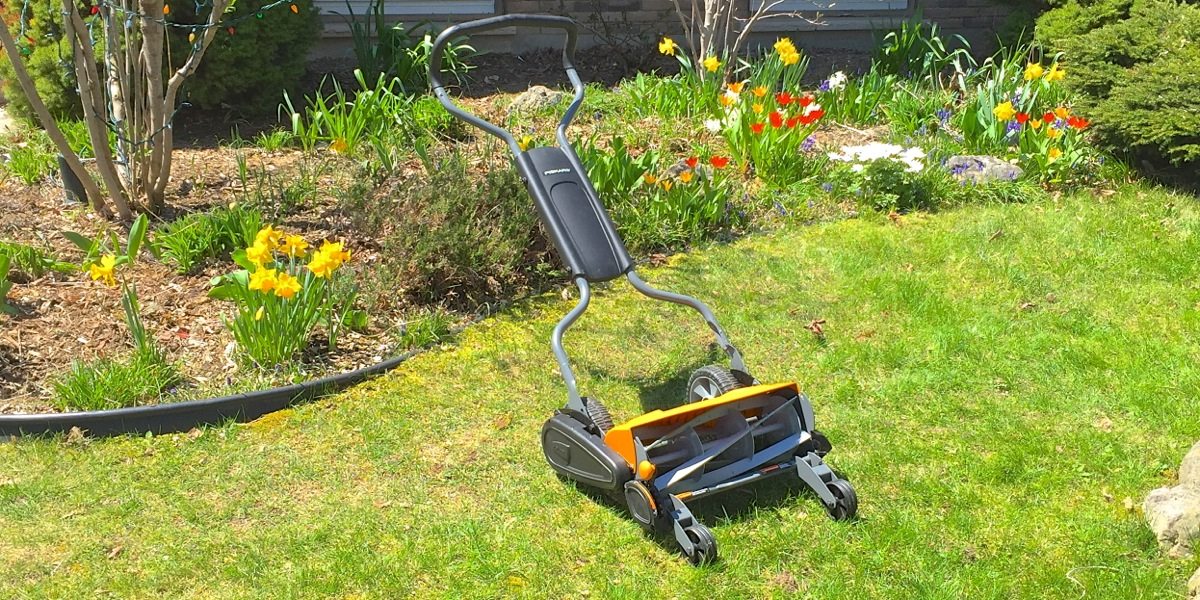The Majapahit empire is expanding. Gain the esteem of the islanders of Buru, and King Hayam Wuruk may appoint you to be his governor.
What Is Buru?
Buru is a worker-placement game for 2 to 4 players (5 with the expansion), ages 12 and up, and takes about 60–75 minutes to play. It’s currently seeking funding on Kickstarter, with a pledge level of $59 for a copy of the core game, or $79 for the deluxe edition that also includes the Ambelau expansion. If your kid has some experience with worker-placement games and bidding games, they could probably pick up on the rules for this one.
Buru was designed by Stephen Selego and Alex Flagg and published by Crafty Games, with artwork by Enggar Adirasa and Dann May. I’ll also note that Kris Ardianto and Kevin Hendranata from Indonesia-based Ketchup Games were hired as cultural consultants.
New to Kickstarter? Check out our crowdfunding primer.

Buru Components
Note: My review is based on a prototype copy and plays in Tabletop Simulator, so it is subject to change and may not reflect final component quality. For instance, several of the components in the prototype are simple rectangles/circles but will most likely be custom shapes in the final product, such as the ship player mats, the altars, and the explorer pawns. The large spirit totems in the prototype were 3D printed plastic but would be wooden in the finished version. The spirit altars are cards in the prototype but will probably be cardboard tiles.
Here’s what comes in the box:
- Game board
- Emissary (first player) marker
- 14 Forest cards
- 13 Elder cards
- 36 Islander cards (9 each Artisan, Gatherer, Noble, Priest)
- 4 Ship mats
- 11 Decree tokens
- 20 Explorer tokens (5 per player)
- 8 Fish tokens (2 per player)
- 4 scoring tokens (1 per player)
- 25 Clay tokens
- 25 Palm tokens
- 25 Ebony tokens
- 3 Spirit Totems (Gunung, Banyu, Manuk)
- 30 Tribute cards (10 each for Gunung, Banyu, Manuk)
- 3 Spirit Altars (Gunung, Banyu, Manuk)
The circular game board has a lot of ornamental decoration inspired by Indonesian art, with four scenes illustrated in the regions where you’l place your explorer pawns—you’ll see more of those later in the How to Play section. The action spaces around the edges are made to look like offering bowls, and the emissary token looks like a temple gate: two angled pillars surrounding a rectangular cutout. The illustrations on the cards and the board depict the islanders of Buru in various activities; they’re stylized but not too cartoony, and help give the game a distinctive look.

The spirit tokens are quite large, and represent the three spirits of the island: Gunung the mountain, Banyu the water, and Manuk the bird.
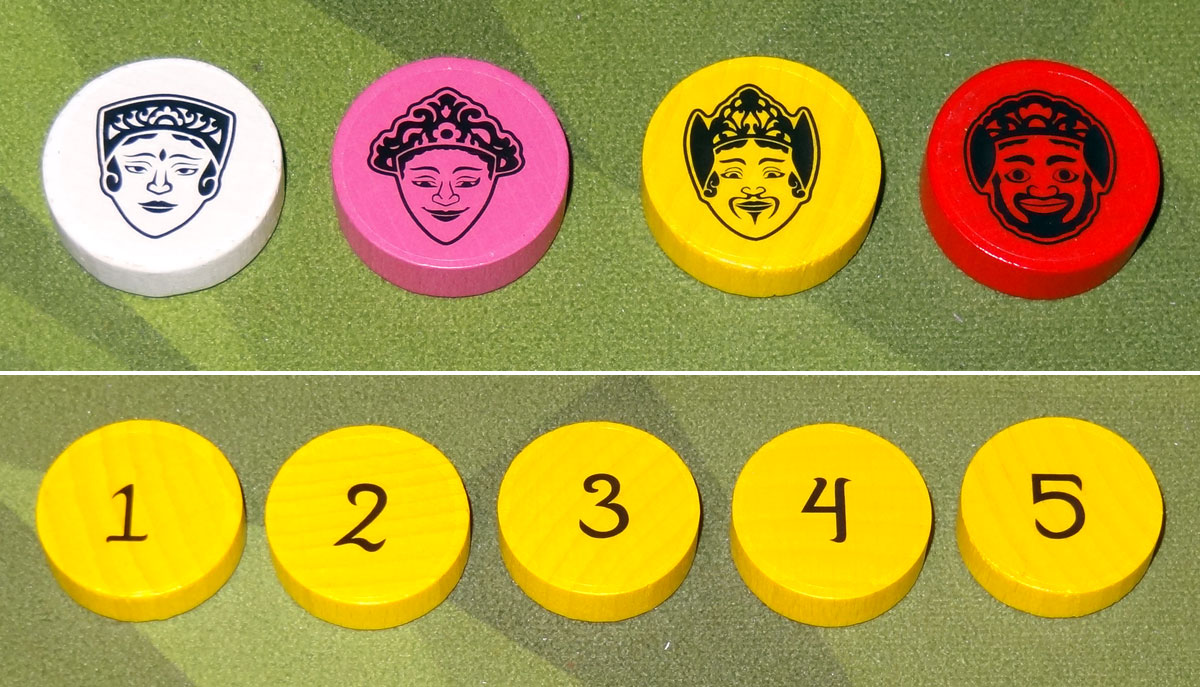
The explorer tokens have different faces for each player and will likely be cut out rather than circles; the faces not only give a little more personality than a generic token but also give another way to tell the pieces apart other than by color. The backs of the tokens have numbers from 1 to 5, representing the power of the explorer.
Throughout the game, on the board and the forest cards, there are sets of 3 small circles, some of them colored red. These are indicators of the value of the action or card: the more red circles, the better it is. While in some cases it may seem obvious that one action is better than another, it’s a nice indicator that makes the game more approachable for new players, too.
How to Play Buru
You can download a copy of the rulebook here, and it’s also available to play on Tabletop Simulator.
The Goal
The goal of the game is gain the most esteem (points) in 5 rounds.
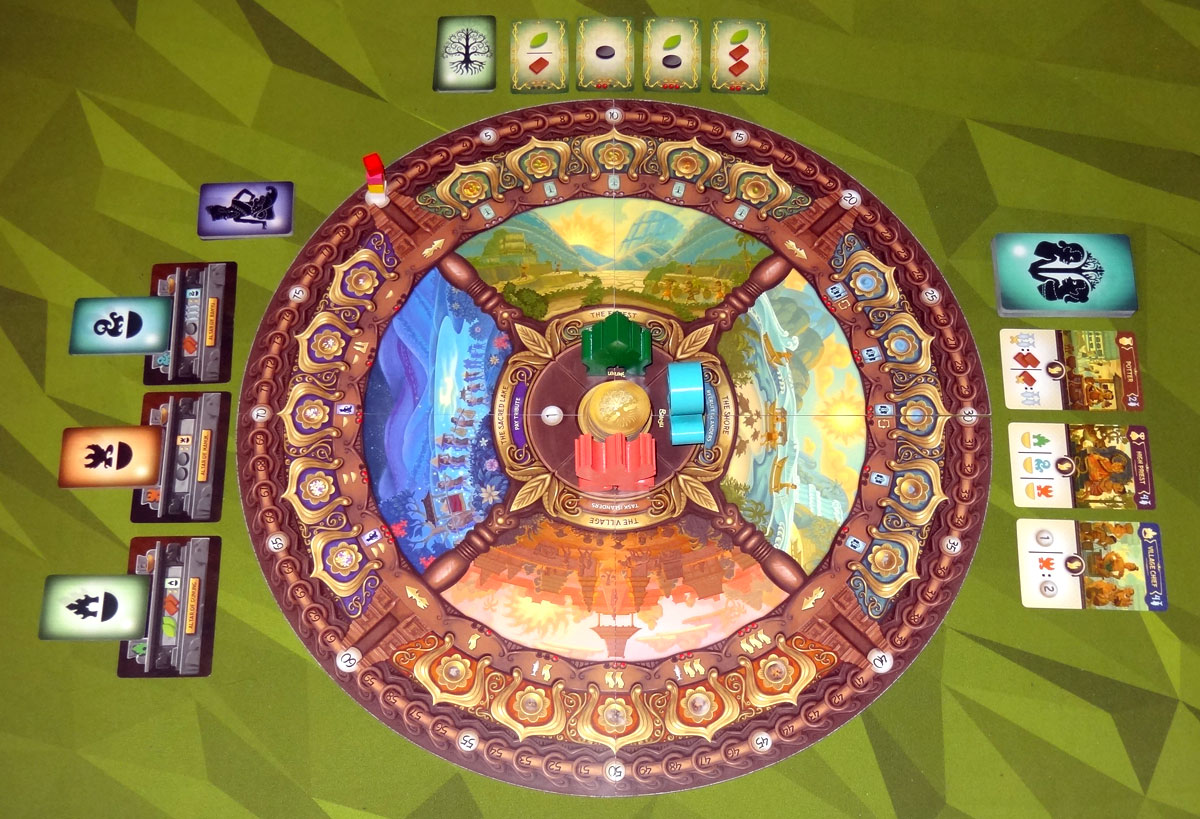
Setup
Set up the main board as follows. Shuffle the decree tokens, stack 10 in the center of the board, and return the last one to the box without looking at it. Place the three spirit totems in their designated spaces near the center of the board.
Shuffle the forest cards and place them near the forest area of the board. Reveal 1 card per player.
Shuffle the Islander cards and place them near the shore. Reveal 3 cards.
Place the altars near the sacred lake. Shuffle each set of tribute cards and place them on the altars. Shuffle the elder cards and place them nearby.
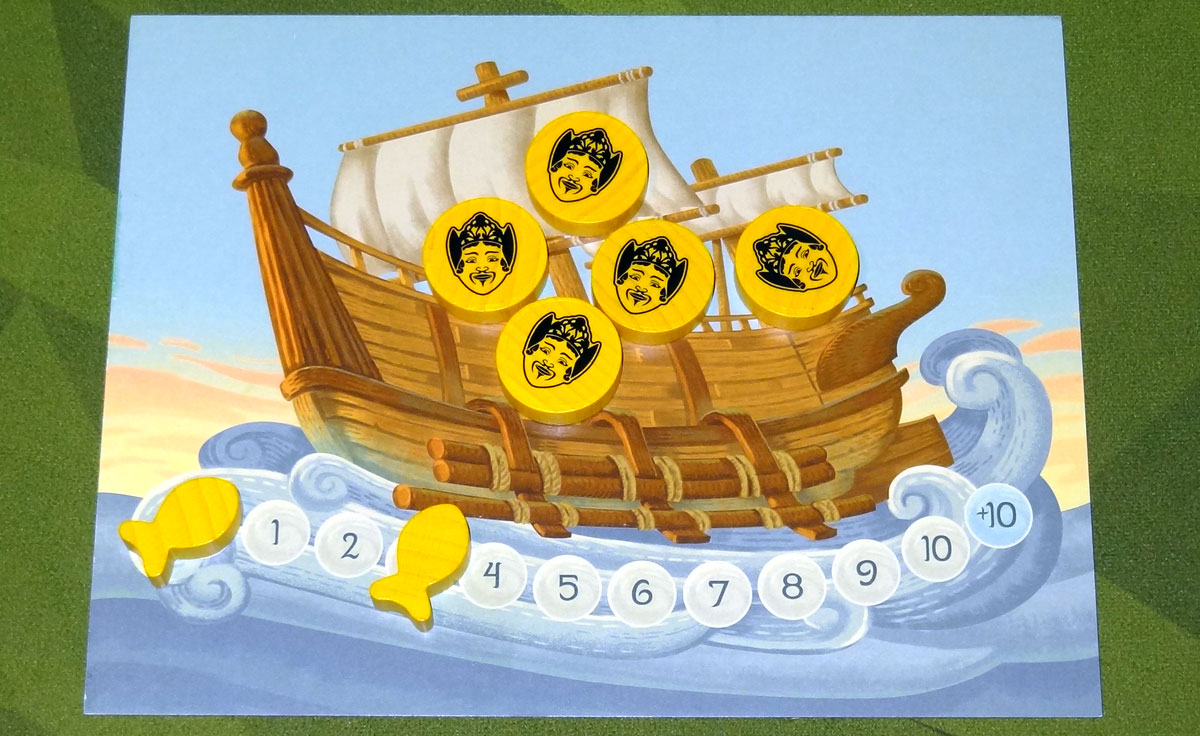
Give each player a player mat, 5 explorers, 2 fish tokens, and a scoring marker. Place all scoring markers on the “0” space on the main board. Choose a player to be the starting player and give them the emissary marker; all other players start with 3 fish (tracked on the ship mat with the tokens).
Gameplay
Each round, players will take turns sending their explorers to the four different regions, and then resolve the actions in those regions based on the power of the explorers.
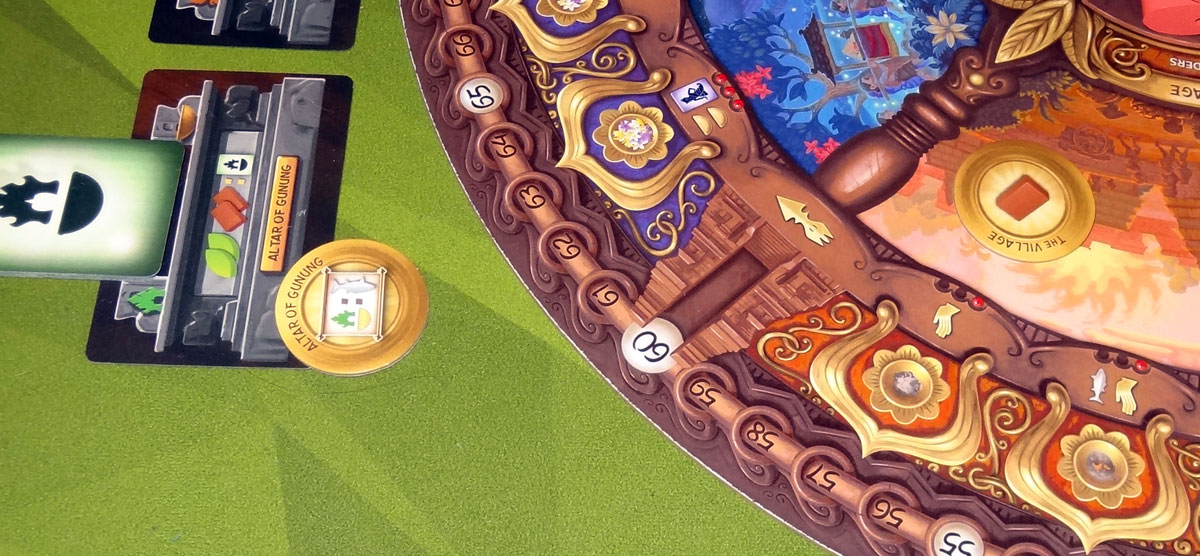
At the beginning of the round, reveal the top two decree tokens and place them in their corresponding areas. Most of the tokens will go to one of the board regions, but some are tied to a specific altar. The region tokens show a bonus you’ll get for controlling a region, and the altar tokens show a bonus you get if you pay tribute at that altar this round.

Players then take turns placing their explorers (number-side down) onto the four regions of the board one at a time, until everyone has placed four explorers. Your last explorer is placed on your boat; reveal its power and gain that much fish. Then, the regions are resolved in clockwise order, starting with the forest.

When resolving a region, first reveal all of the explorer tokens: the player with the highest total power is “triumphant” in that region. (Ties are broken going clockwise starting with the player with the emissary token.) The triumphant player gains any bonuses for that region: three of the regions allow the player to take the spirit totem, and the sacred lake awards the player 1 esteem point. In addition, if there are any decree tokens in that region, the player gains the bonus depicted as well.
Then, in order of descending power, each player present in the region will take one action, placing their explorers on an action space. Note that even if you have multiple explorers in the same region, you will still take only a single action, using a single space.
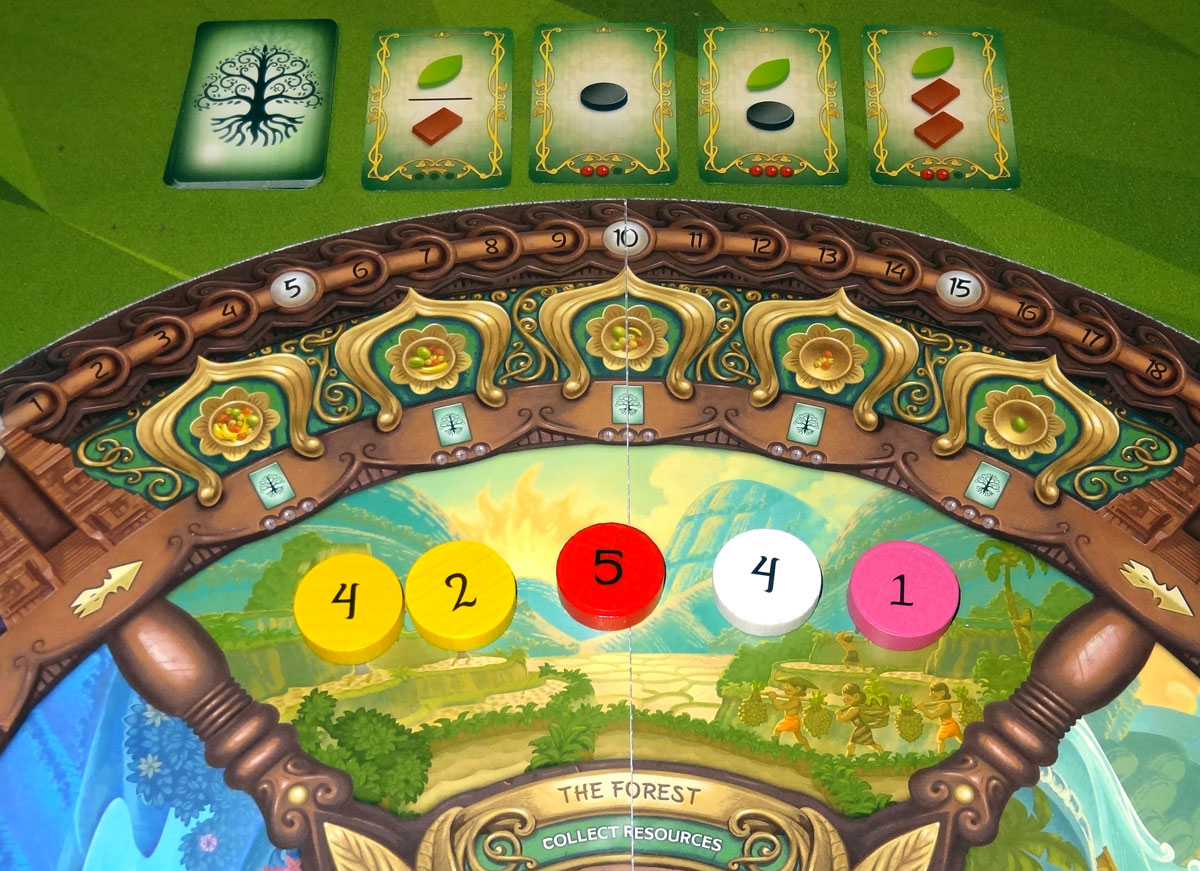
In the forest, each action space lets you choose one of the forest cards to gain resources—the spaces on the board are all equivalent, but since the market does not refill until the start of the next round, the player who goes first will have the most options to choose from. Discard the forest card and take tokens from the supply.

At the shore, players will spend fish to recruit islanders, placing the cards near their boats. The action spaces on the board will allow you to recruit one or two islanders, and some spaces will also allow you to wipe and refresh the market once during your turn. The cost to recruit the islander is at the top right of the card, and the icon at the top left shows which type of islander it is, with the ability at the bottom. The market is refilled immediately each time you recruit an islander.

The village allows you to activate the islanders you’ve recruited. Each hand icon lets you activate one islander, rotating the card 90 degrees to indicate that you’ve used them this round. Depending on which action space you take on the board, you’ll be able to task 1 to 3 islanders, and some spaces also let you gain a fish.
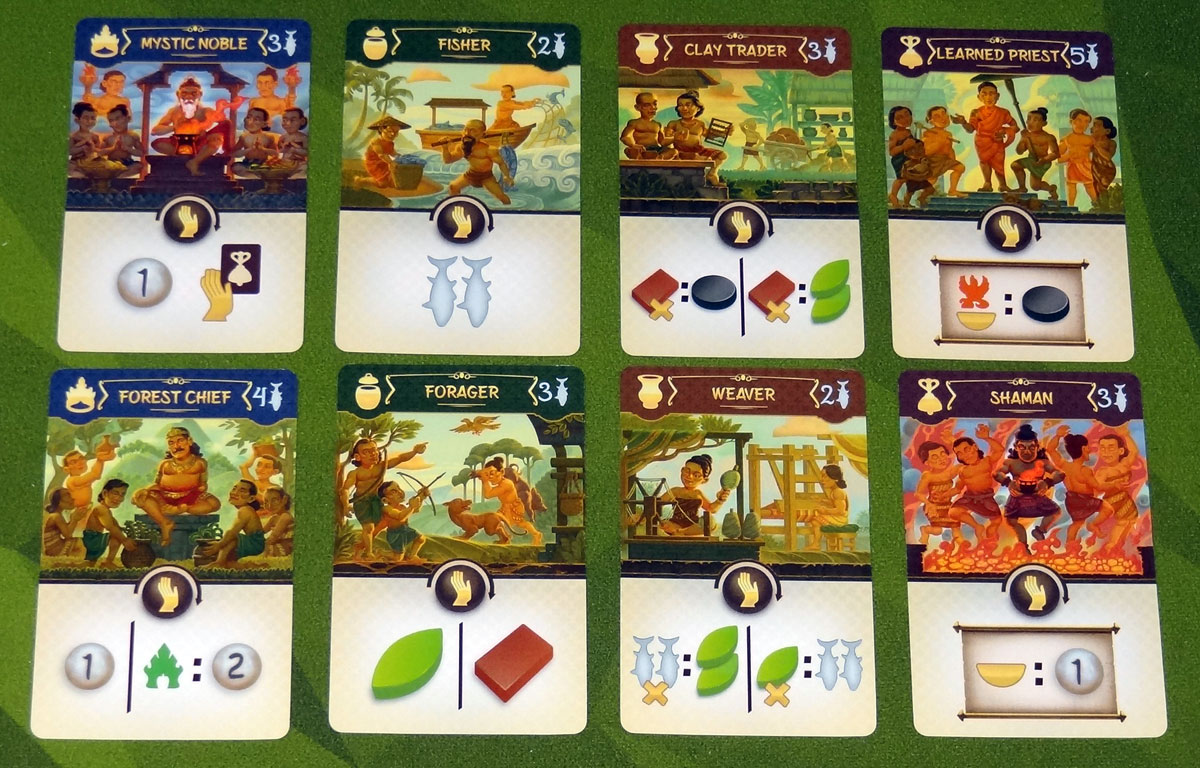
The four types of islanders do different things:
- Nobles give you esteem, and some also let you task a specific type of islander, which is like a bonus activation.
- Gatherers give you resources.
- Artisans let you trade resources or fish.
- Priests provide bonus effects related to paying tributes.

The action spaces at the sacred lake have three different effects. Each bowl icon allows you to offer one tribute. The card icon lets you draw 2 elder cards and keep one. The emissary icon lets you take the emissary token for the next round.

To offer a tribute, pay the resources shown on the altar back to the supply, and then take a card from that tribute deck. If you have the spirit totem, then whenever any player offers a tribute to that spirit, you gain 1 esteem.

The elder cards will give you points at the end of the game for fulfilling the conditions on them. For instance, it may want you to collect a specific resource, recruit a number of islanders, or hold a particular spirit totem when the game ends. Most have 3 levels—you will score for the highest level that you complete.
After resolving the sacred lake region, the round is over and you set up for the next round: discard the decree tokens. Take all of your explorer tokens back. Reset all of your tasked islander cards back to vertical. Discard any remaining forest cards and replace them.
Game End
The game ends after the 5th round, at which point there will be no more decree tokens. Gain esteem for all of your collected tribute cards, as well as elder cards if you’ve fulfilled the requirements. The highest score wins; ties are broken going clockwise starting with the emissary.

Why You Should Play Buru
Before I dig into the gameplay, I wanted to talk about the theme: it’s set in 14th century Indonesia, during the period in which King Hayam Wuruk expanded his kingdom across these scattered islands (including Buru). It’s a period depicted as a golden age, the largest empire in Southeast Asia, and its influence can still be seen in modern-day Indonesia. I didn’t know much about it before playing Buru, but the brief description provided in the rulebook made me wonder a bit: was this another game about empire-building, a theme that has increasingly been criticized for glorifying imperialism and colonialism? Personally, I’ve found myself generally less excited to play games that involve exploiting indigenous peoples—or games that gloss over the ugly realities underlying the theme.
That led me to poke around a bit, though admittedly most of what I could find was through Wikipedia. There aren’t a lot of primary sources available, and since history is written by the victors, the fact that there’s an epic poem celebrating Hayam Wuruk doesn’t necessarily prove much. It does sound like the Indonesian empire relied more heavily on diplomacy than warfare, and that in some cases being spread out across so many islands meant that it was an empire in name more than in practice, and this is reflected in the gameplay, where you’re recruiting islanders and respecting their traditions rather than just battling and conquering them. In practice, though, you’re still moving into occupied lands and competing to become governor.
I know that Crafty Games hired an Indonesian publisher, Ketchup Games, to consult on the project, as well as Indonesian artist Enggar Adirasa (working with Dann May, who is Australian). However, I did wonder if that’s a bit like asking Americans of European descent to consult on a game about settling the United States, rather than Native Americans. There are indigenous people of Buru (Wikipedia says about a third of the population now), but Crafty Games was unable to find a local consultant despite their attempts. Is it better, or worse? What does this mean for the game Buru? Well, I appreciate that Crafty Games has made efforts to approach their game in a respectful way, though I can’t answer the question of whether they’ve succeeded. It does seem a little unfair to hold them to a higher standard than games about European colonialism, but it’s a topic that has been on my mind recently, and I figured it was worth mentioning. It did inspire me to read and think more about a region of the world that I was largely ignorant of, something that doesn’t always happen with games.
So, then, what’s the gameplay like?
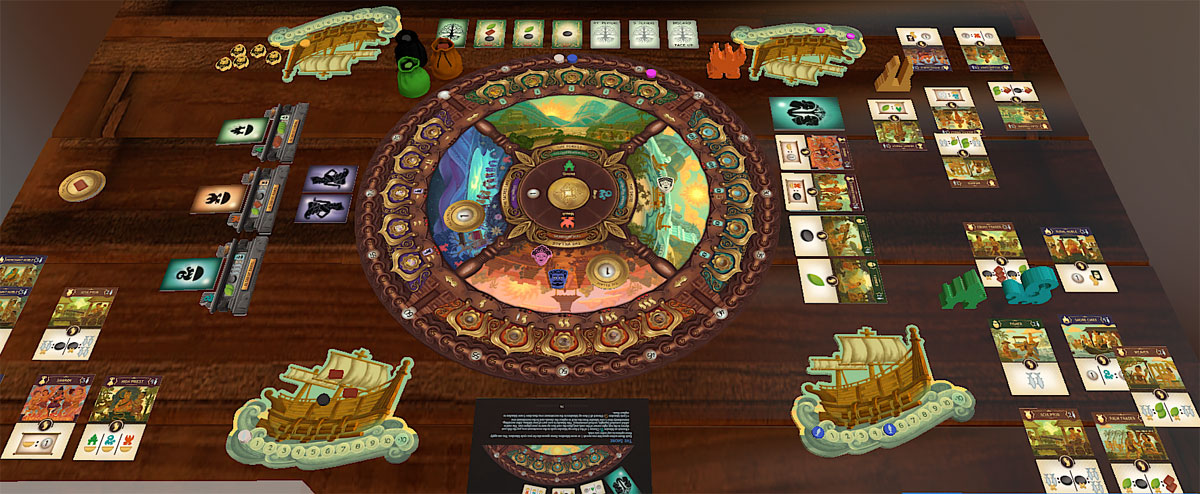
The game itself doesn’t feel too complicated, and for the most part I think will be easy to follow for those who have some experience with Euro-style games: you collect various resources, using them to hire islanders who can help you manipulate resources, with the goal of spending them at one of the altars for points. Elder cards also give you some hidden goals to work toward, giving you points if you meet certain requirements. This part of the game seems familiar: resource management and action management in deciding which islanders to task each turn.
Where things got interesting for me is the way worker placement is used, which I haven’t seen in many games before. You aren’t just placing a worker in a space to get an action, but to place a bid on going first for that action—you can think of it like an auction, or like area control, and the decrees give some regions a bonus value each round. Because the values of the explorers are hidden, you can tell which region another player is bidding on, but you don’t know exactly how much until they’re revealed. It makes it a little closer to a blind auction, though with turn order, and that means it’s possible to severely overbid because you expect other people to want the same action.
I’m typically pretty bad at auction games, and I found that carried over somewhat to Buru as well: there were times where I put my strongest workers in regions, only to find out that nobody else was even trying to win, and times where I smacked myself because I let somebody win a region with a “2.” What’s also interesting is that you can place more than one worker in a region to increase your bid—but you still only get a single action there, so you’re giving up an action in another region to do so.
You’re always guaranteed an action if you place an explorer in a region—there’s always at least one space per player—but the strength of that action can vary a bit. That can make mistakes a little more forgiving, but also felt sometimes like the stakes weren’t as high. In some cases, like if you really wanted an Elder card or the Emissary token, there aren’t enough spaces for everyone to do so, but if you’re gathering resources or recruiting an islander, simply going to a region will allow you to take at least the basic action.
I also liked the fact that your fifth explorer was how you gained fish—if you have a good supply of fish, then you can spend a lower number on fish and bid higher for actions. Or if you notice a player is totally out of fish, then you can guess they might not place their “5” explorer in a region that round. It’s a clever mechanic, and gives you something else to think about as you’re planning out your bids.

One thing I hadn’t really paid attention to the first couple times I played was how central the tributes are to victory. Sure, there are several ways to score points—Elders, noble islanders, holding a totem when other players are paying tribute—but the tributes themselves are your primary method of scoring, and you can’t really compete by just combining the other things. The tribute cards have a range of point values, but even the least valuable is still typically a better cost-per-point ratio than fulfilling the Elder goals. So if you like games where there are multiple approaches to victory, you might feel limited by having to focus on tributes specifically. Some of the expansions (which I haven’t covered here) do add some additional ways to score and new types of tributes, but I haven’t played those to know whether they’re enough to overcome a focus on making tributes to these specific spirits.
Overall, Buru is a solid worker-placement game with a creative use of the placement as bidding; the rest of the game doesn’t necessarily feel like it breaks a lot of new ground in how the actions are used. I do feel the game stands out both for its setting and its appearance, which is visually striking. There are some planned expansions that may be made available through the Kickstarter campaign that look intriguing, though I’ve only looked at the rules and did not play them myself since the Tabletop Simulator module didn’t include them at the time. I think they’ll increase the stakes a little in the bidding, particularly the one that adds a 5th action, because then it means you’ll always have to decide which action you’re going to skip each round.
For more information or to make a pledge, visit the Buru Kickstarter page!
Click here to see all our tabletop game reviews.
![]() To subscribe to GeekDad’s tabletop gaming coverage, please copy this link and add it to your RSS reader.
To subscribe to GeekDad’s tabletop gaming coverage, please copy this link and add it to your RSS reader.
Disclosure: GeekDad was loaned a prototype of this game for review purposes.
